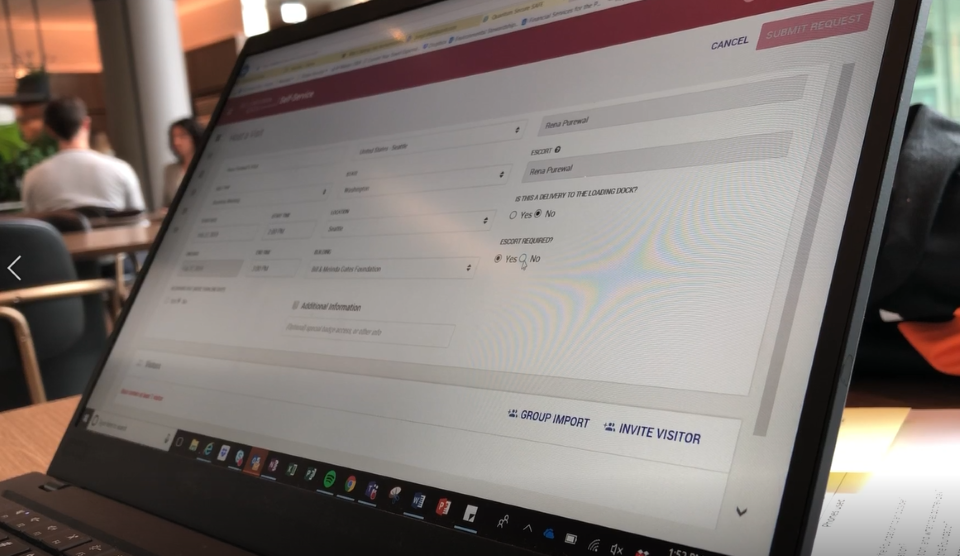The aging visitor management system (VMS) at the Foundation had hit end of life. Rather than just simply starting from scratch, the product team wanted to learn from the current system’s strengths and weaknesses to ensure the replacement system has parity and perhaps exceeds prior standards. However, the need to complete a requirements document for the vendor was urgent due to continuing issues with the current system.
Project Team
I was the sole user experience design resource on this project, and I was only allocated on a temporary basis. I engaged deeply during the discovery phase (3-4 weeks), intermittently during business requirements, and part time during the evaluation phase (8 weeks). My primary partner was the program manager for the project, and I also worked closely with the in-house developer working on the integration with the vendor code.
Phase 1: Discovery
The discovery phase was under an intense time constraint, as there were existing vendor kickoff and delivery dates we had to influence. Any interviewing and reporting had to be completed within a few weeks’ time.
Step 1: Project team engagement (1 week)
I attended a few kickoff sessions with the system vendor and the project team. HCD participation in these discussions informed interview questions, raised new questions for the vendor, and set the scope for our future engagement. I was able to move directly into the interview stage because my product team partners had already identified the key customers we should speak with during interviews and gained their buy-in.
Step 2: Interviews & Observation (1.5 weeks)
Over the course of a week and a half, I conducted 5 interview sessions and informal job shadows where I watched customers interact with the existing VMS. Each interview was audio recorded and transcribed for analysis.
Step 3: Analysis and Findings (1 week)
I reviewed the content of the 5 interviews, paying particular attention to the customer goals as they used the software. What were they trying to achieve, and what else is going on that might influence their situation? This analysis of customer goals led me to three sets of insights:
- Key pain points observed or reported in the existing VMS
- A set of user roles: patterns of user goals and responsibilities
- Jobs to be done: for each role, the specific “real-world” tasks for which they might need VMS
Phase 2: Inform Business Requirements
Co-design workshop with stakeholders
HCD joined a working session between the project team, the third party partner, and some power users of VMS. We used the user roles and jobs to be done as a shared lens through which we could evaluate proposed requirements in-session.
Participation in business requirement reviews
I then participated in the lengthy review process for the business requirements themselves, ensuring that the needs of customers as revealed through the discovery process were represented accurately.
Key features inspired by discovery insights:
- Notification of an unescorted visitor
- Ability to add more than one contract ID in a single visit
- Ability to specify an alternate host to support Program Assistants arranging but not greeting visitors
Phase 3: Evaluation (8 weeks, part time)
Heuristic Review
Walked through initial design proposals (in Adobe XD) from the vendor company, providing feedback based on industry best practices and informed by our earlier discovery into BMGF’s specific customer needs and roles
Usability study
Once a functional version of the site was live, I designed and ran a usability study with representatives from key employee groups and delivered the resulting insights back to the VMS team on a tight timeline. This was actually two usability studies – one with end users of the actual portal for entry of visitors, and one specifically for the front desk users. The front desk testing uncovered SIGNIFICANT blocking issues that ended up pushing back our launch date.
Customer outreach mentoring
As my time to re-engage was limited due to my involvement on the Teams Enablement project, I sought to empower our product management partners to open up an effective long-term communication channel with their customers. I provided coaching on HCD interviewing techniques and helped set up a beta program for the new VMS, providing tasks for them to complete during the program.
Functional evaluation
Direct HCD evaluation of the functional VMS build as it evolved. Submission of bugs and change requests drawn from industry best practice, customer feedback, and deviations from original requirements.
Impacts and outcomes
- The user roles and “jobs to be done” helped us ensure that our evaluations of business requirements were always targeted to specific customer needs.
- Pain points led to new requirements: for example, the report from our China office that batch import did not support double-byte characters leading to significant time loss.
- Usability testing and expert reviews uncovered significant issues in early vendor deliveries that helped us make informed decisions about launch timelines, preventing any disruption to the foundation’s daily operations.







